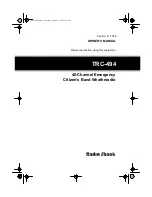
20
T2020 Operator's Manual
keying the label or acronym into it, until it has enough characters to be able to
distinguish the word from all similar words it has in its memories.
For example:
Suppose your radio has two channel labels programmed into it: BASE and
BASIL. To call up the BASE channel, you key in [A
B
C]; [
A
BC]; [PR
S
]. The
radio cannot yet distinguish whether you want BASE or BASIL so it places
"***" in the display. But when you key in the fourth letter, [D
E
F], the radio
knows you do not want BASIL (or you would have keyed in [GH
I
]) and so it
is able to acknowledge the entry properly and displays "
BASE
".
Note that in choosing labels or acronyms, you should avoid words which are
indistinguishable to the radio, e.g. BASE and CAPE. Both use the same key
sequence, [ABC]; [ABC]; [PRS]; [DEF]. You will only be able to find them
separately with the
or
keys.
or
or
When the "
>?
" indicator appears in the display, these keys act as up / down
scrolling keys to enable you to search through a list of choices. They are used
in conjunction with the
,
,
and
keys.
When the "
>?
" indicator is not visible in the display, these keys act as dialling
keys for Selcall and DTMF dialling. In Selcall dialling mode the
key
may be used in place of the
key, and the
key may be used as a 'wild
card' digit to make group calls.
Appendix A2
Indicator And Display Functions
Explained
!
!
!
!
'Call' indicates that your radio has received a Selcall call. If it is intended
specifically for you alone, your radio will also sound a ringing tone,
burr,burr
...burr,burr
. If the call is a group call intended for several users at once, your
radio will sound only one sequence of this ringing tone,
burr,burr.
If the 'Call'
indicator is flashing, your radio received a call which you were unable to
answer. It will only indicate who the call was from if that option is fitted.
Summary of Contents for t2020
Page 1: ...T2020 Operator s Manual...
Page 27: ...T2020 Operator s Manual 23...




































